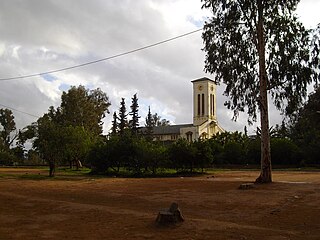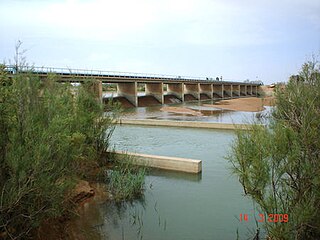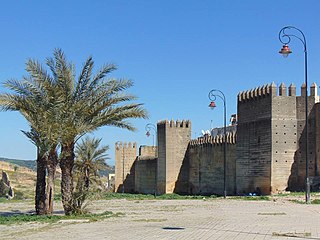
Essaouira, known until the 1960s as Mogador, is a port city in the western Moroccan region of Marrakesh-Safi, on the Atlantic coast. It has 77,966 inhabitants as of 2014.

Ouarzazate, nicknamed the door of the desert, is a city and capital of Ouarzazate Province in the region of Drâa-Tafilalet, south-central Morocco.

A mellah is the place of residence historically assigned to Jewish communities in Morocco.

Ksar el-Kebir, also known as al-Qasr al-Kabir, is a city in northwestern Morocco, about 160 km north of Rabat, 32 km east of Larache and 110 km south of Tangier. It recorded a population of 126,617 in the 2014 Moroccan census.

Mohammedia, known until 1960 as Fedala, is a port city on the west coast of Morocco between Casablanca and Rabat in the region of Casablanca-Settat. It hosts the most important oil refinery of Morocco, Samir Refinery, which makes it the center of the Moroccan petroleum industry. It has a population of 208,612 according to the 2014 Moroccan census.

Settat is a city in Morocco between the national capital Rabat and Marrakesh. Settat is located 83.9 km (52.1 mi) by road south of the centre of Casablanca, roughly an hour's drive. It is the capital of Settat Province and is its largest city in both size and population. According to the 2014 Moroccan census, it had a population of 142,250 people, up from 116,570 people in the 2004 census. Settat is 370 m (1,210 ft) above sea level, built on a plateau surrounded by foothills in all directions. The antiquities of Settat include the very old Ismailiya Kasbah distinguished by the statue of a steed which lies at the center of the city.

Khemisset is a city in northern Morocco with a population of 131,542 recorded in the 2014 Moroccan census. It is situated on the A2 motorway between Rabat (81 km) and Meknès (57 km), and is the capital of Khémisset Province.

Dakhla-Oued Ed-Dahab is one of the twelve regions of Morocco. Before September 2015 it was known as Oued Ed-Dahab-Lagouira. It is situated in the disputed territory of Western Sahara, considered by Morocco to be the southern part of the country. The Polisario Front and other independence-seeking Sahrawis consider this to be a part of the Sahrawi Arab Democratic Republic. The United Nations and most countries do not recognize Moroccan sovereignty over the area.

Fes Jdid or Fes el-Jdid is one of the three parts of Fez, the second largest city of Morocco. It was founded by the Marinids in 1276 as an extension of Fes el Bali and as a royal citadel and capital. It is occupied in large part by the historic Royal Palace, which was once the center of government in Morocco and which is still used on occasion by the King of Morocco today. The district also contains the historic Mellah of the city. Since 1981 it has been classified, along with Fes el-Bali, as a UNESCO World Heritage Site.
Ifrane is a province in the Moroccan region of Fès-Meknès. Its population in 2013 was 156,038

Oued Zem is a city in Khouribga Province, Béni Mellal-Khénifra, Morocco. According to the 2014 Moroccan census, Oued Zem had a population of 95,267.
Ait Attab is a large agricultural river valley on the northern edge of Azilal province in Morocco. Its population is divided into a multitude of hamlets called douwars, the largest one being Al Garage, which is also referred to as Ait Attab Center, or more simply as Ait Attab.

The Berrechid–Beni Mellal expressway (A4) was inaugurated in 2015. It runs mainly parallel with the existing Route Nationale 12.

Oued Guir is an intermittent river or wadi that flows through the Drâa-Tafilalet and Oriental regions in southeastern Morocco and Béchar Province in western Algeria.

NGC 4036 is the New General Catalogue identifier for a lenticular galaxy in the northern circumpolar constellation of Ursa Major. In the Carnegie Atlas of Galaxies, it is described as being "characterized by an irregular pattern of dust lanes threaded through the disc in an 'embryonic' spiral pattern indicating a mixed S0/Sa form." It is located near the Big Dipper, a little to the north of the mid-way point between the stars Alpha Ursae Majoris and Delta Ursae Majoris. With a visual magnitude of 10.7, it can be dimly viewed using a 4 in (10 cm) aperture telescope.

Casablanca-Settat is one of the twelve administrative regions of Morocco. It covers an area of 20,166 km2 and recorded a population of 6,861,739 in the 2014 Moroccan census, 69% of which lived in urban areas. The capital of the region is Casablanca.

The Royal Palace or Dar al-Makhzen is the palace of the King of Morocco in the city of Fez, Morocco. Its original foundation dates back to the foundation of Fes el-Jdid, the royal citadel of the Marinid dynasty, in 1276 CE. Most of the palace today dates from the 'Alawi era. The vast grounds are home to multiple private structures, patios, and gardens, but historically also included administrative offices and government tribunals. Today, the most publicly visible parts of the palace are its main entrances at the Old Mechouar and the highly ornate 20th-century gates at Place des Alaouites, near the Mellah.

The Fortifications of Fez comprise a complex circuit of ramparts and gates surrounding Fes el-Bali and Fes el-Jdid, two urban agglomerations that compose the old "medina" of Fes, Morocco. They also include a number of kasbahs (citadels) and forts which were built both to protect and to control the city. These fortifications have been built up over many centuries and the extensive remnants today date from many different periods.

The Mellah of Fez is the historic Jewish quarter (Mellah) of Fez, Morocco. It is located in Fes el-Jdid, the part of Fez which contains the Royal Palace, and is believed to date from the mid-15th century. While the district is no longer home to any significant Jewish population, it still contains a number of monuments and landmarks from the Jewish community's historical heritage in the city.

The Mellah of Marrakesh, formerly known as Hay Essalam is the Jewish Quarter (Mellah) of the city of Marrakesh, Morocco. It is the second oldest of its kind in the country.



















